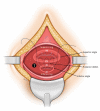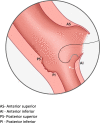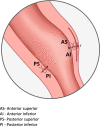Repair of the myometrial scar defect at repeat caesarean section: a modified surgical technique
- PMID: 34404382
- PMCID: PMC8369636
- DOI: 10.1186/s12884-021-04040-9
Repair of the myometrial scar defect at repeat caesarean section: a modified surgical technique
Abstract
Background: To investigate whether the existing surgical technique for uterine closure at repeat lower segment Caesarean section (LSCS) can be modified to achieve adequate residual myometrial thickness (RMT) to ensure scar integrity and reduce complications in future pregnancy.
Methods: Women with a significant scar defect at repeat LSCS had the anterior uterine wall closed by a single experienced obstetrician with a technique focused on recognition, mobilisation and apposition of the retracted myometrial edges at the boundary of the defect. This was aimed at anatomical restoration of the lower segment. The RMT at the scar area was assessed by postnatal pelvic ultrasound scan at three months.
Results: Thirty women with a history of at least one previous CS, incidentally found to have a large defect at operation underwent the technique with prior consent. A postnatal scan showed a mean residual myometrial thickness of 8.4 mm (SD ±1.3 mm; range 5.6-11.0 mm). The average operating time was 91 mins and the average blood loss 728 ml. Two women who underwent the repair have gone on to have a further uneventful CS.
Conclusion: This modified technique resulted in scan evidence of an RMT indicative of uterine wall stability postnatally and offers the potential for reducing the risk of rupture and placenta accreta spectrum (PAS) in future pregnancy.
Keywords: Caesarean scar dehiscence; Myometrial repair; Residual myometrial thickness.
© 2021. The Author(s).
Conflict of interest statement
The authors have no potential conflict of interest pertaining to this study and submission.
Figures





Similar articles
-
Conservative surgical approach towards placenta accreta spectrum disorders for uterine preservation.BMC Pregnancy Childbirth. 2023 Jan 14;23(1):28. doi: 10.1186/s12884-023-05370-6. BMC Pregnancy Childbirth. 2023. PMID: 36641463 Free PMC article.
-
Repair of a chronic myometrial defect with successful pregnancy outcome.Fertil Steril. 2024 Jan;121(1):123-125. doi: 10.1016/j.fertnstert.2023.09.014. Epub 2023 Sep 23. Fertil Steril. 2024. PMID: 37748550
-
Does ultrasound-guided intervention during repeat cesarean sections improve uterine scar architecture and reduce the number of scars? A prospective controlled clinical intervention trial.J Perinat Med. 2018 Oct 25;46(8):857-866. doi: 10.1515/jpm-2017-0394. J Perinat Med. 2018. PMID: 29570454 Clinical Trial.
-
Uterine scar rupture - Prediction, prevention, diagnosis, and management.Best Pract Res Clin Obstet Gynaecol. 2019 Aug;59:115-131. doi: 10.1016/j.bpobgyn.2019.01.009. Epub 2019 Feb 10. Best Pract Res Clin Obstet Gynaecol. 2019. PMID: 30837118 Review.
-
Should Cesarean Scar Defect Be Treated Laparoscopically? A Case Report and Review of the Literature.J Minim Invasive Gynecol. 2015 Nov-Dec;22(7):1145-52. doi: 10.1016/j.jmig.2015.06.013. Epub 2015 Jun 26. J Minim Invasive Gynecol. 2015. PMID: 26122897 Review.
Cited by
-
Laparoscopic Cesarean Scar Defect Repair in Six Steps.Gynecol Minim Invasive Ther. 2024 Oct 21;13(4):276-277. doi: 10.4103/gmit.gmit_78_24. eCollection 2024 Oct-Dec. Gynecol Minim Invasive Ther. 2024. PMID: 39660233 Free PMC article. No abstract available.
-
Conservative surgical approach towards placenta accreta spectrum disorders for uterine preservation.BMC Pregnancy Childbirth. 2023 Jan 14;23(1):28. doi: 10.1186/s12884-023-05370-6. BMC Pregnancy Childbirth. 2023. PMID: 36641463 Free PMC article.
-
Previous caesarean scar defect, an unusually described cause for post-partum haemorrhage (PPH): is it time for a dedicated scar team to manage postpartum complication after previous caesarean section?Arch Gynecol Obstet. 2024 Jun;309(6):2945-2950. doi: 10.1007/s00404-024-07501-6. Epub 2024 Apr 4. Arch Gynecol Obstet. 2024. PMID: 38573355 No abstract available.
-
Inadvertent Laparoelytrotomy During the Second-Stage Cesarean Section: Relooking the Lost Art and Proposing Surgical Management and Prevention Strategies.Matern Fetal Med. 2023 Sep 25;6(1):9-12. doi: 10.1097/FM9.0000000000000197. eCollection 2024 Jan. Matern Fetal Med. 2023. PMID: 40406741 Free PMC article. No abstract available.
-
Analyzing Influencing Factors of Uterine Rupture in Pregnant Women with Scarred Uterus Undergoing Repeat Delivery and Evaluating the Predictive Value of Lower Uterine Anterior Wall Thickness.Int J Womens Health. 2025 Aug 4;17:2421-2431. doi: 10.2147/IJWH.S530520. eCollection 2025. Int J Womens Health. 2025. PMID: 40787585 Free PMC article.
References
-
- Kok N, Wiersma IC, Opmeer BC, de Graaf IM, Mol BW, Pajkrt E. Sonographic measurement of lower uterine segment thickness to predict uterine rupture during a trial of labor in women with previous cesarean section: a meta-analysis. Ultrasound Obstet Gynecol. 2013;42(2):132–139. doi: 10.1002/uog.12479. - DOI - PubMed
-
- van der Voet LF, Bij de Vaate AM, Veersema S, Brolmann HA, Huirne JA. Long-term complications of caesarean section. The niche in the scar: a prospective cohort study on niche prevalence and its relation to abnormal uterine bleeding. BJOG. 2014;121(2):236–244. doi: 10.1111/1471-0528.12542. - DOI - PubMed
MeSH terms
LinkOut - more resources
Full Text Sources

